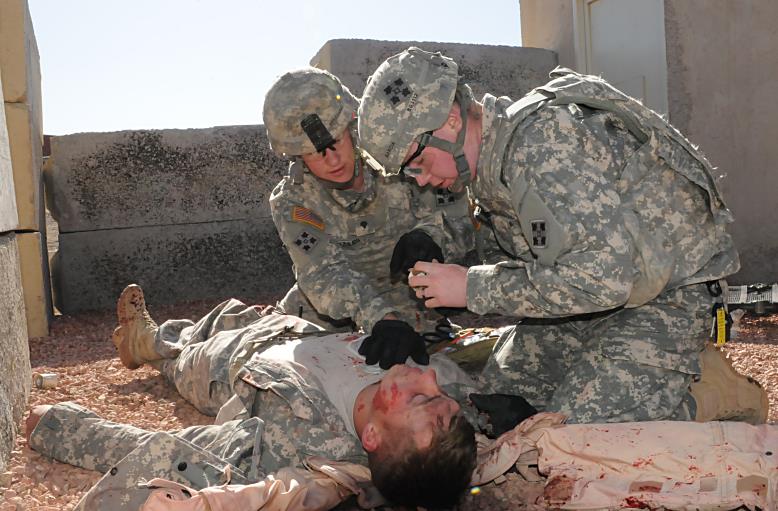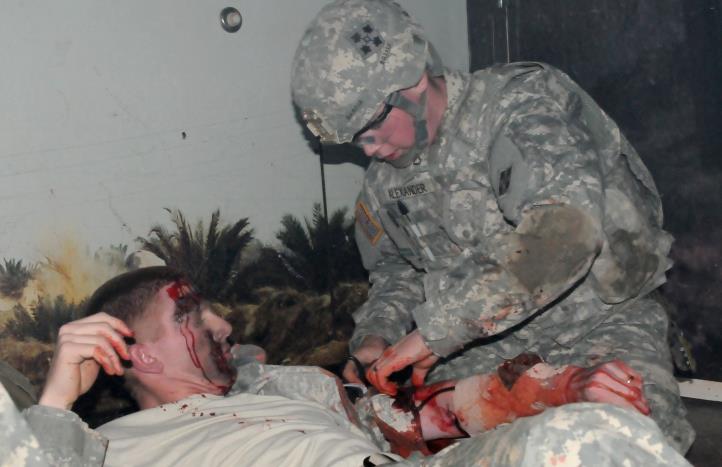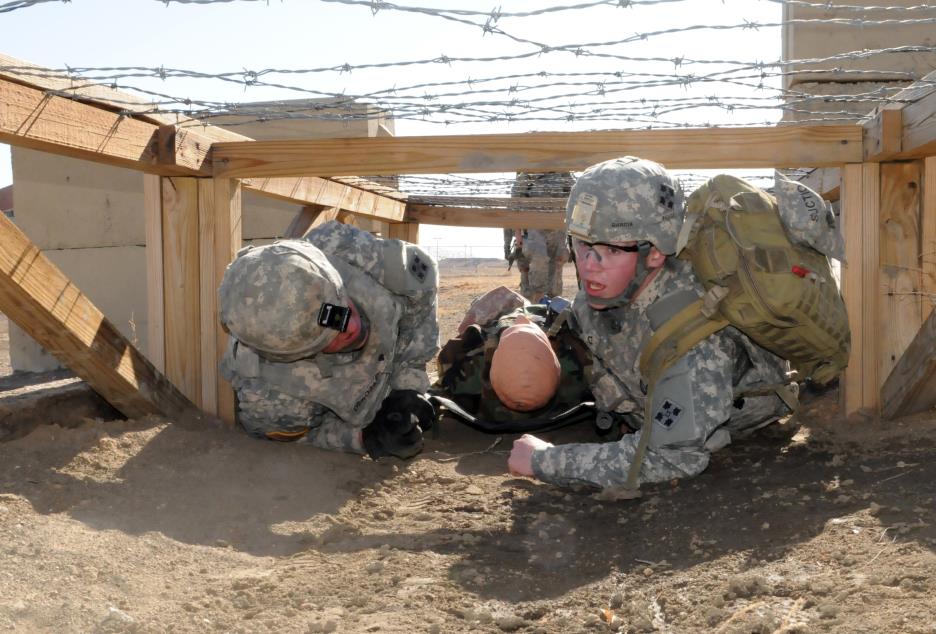![]() 1st Battalion 22nd Infantry
1st Battalion 22nd Infantry ![]()
‘Regulars’ complete realistic medical training to prove their skills
February 2012

Spc. James M. Derozario,
combat medic assigned to Headquarters and Headquarters Company,
1st Battalion, 22nd Infantry Regiment,
“Regulars,” 1st Brigade Combat Team, 4th Infantry
Division, holds a bandage in place over the simulated chest wound
of a role-playing patient
Feb. 28, at the Mountain Post Medical Simulation Training Center,
as Pfc. Michael A. Alexander, combat medic assigned to HHC,
unrolls medical tape to place on the bandaged wound. Derozario, a
native of Denver, Colo., and Alexander, a native of Moncks
Corner, S.C.,
participated in the grueling two-day course Feb. 27-28, to
complete their annual medical recertification process.
Photo by SGT Breanne Pye
by SGT Breanne Pye
1st Brigade Combat Team, Public Affairs Office 4th
Infantry Division
FORT CARSON, Colo. – Health
care specialists, regardless of their skill identifier, must
train to build their expertise
and preparedness in providing first aid to ensure their soldiers
make it home safe.
Combat medics of 1st Brigade Combat Team, 4th Infantry Division,
recently conducted realistic training to ensure
they remain proficient in their life-saving skills on and off the
battlefield.
Twenty “Regulars” medics assigned to Headquarters and
Headquarters Company, 1st Battalion, 22nd Infantry Regiment,
completed their annual recertification at the Mountain Post
Medical Simulation Center, Feb. 27-28.
“This training was incredibly innovative, as it involved
honor students from a local cosmetology school who came in
each morning to apply very realistic theatrical makeup to our
senior medics, who simulated casualties during the course,”
said Sgt. David Haugh, combat medic assigned to HHC.
Haugh, a native of Houston, said the addition of the moulage, the
art of applying make-up to replicate realistic wounds,
and using role-players to simulate live casualties added a level
of intensity to the course, creating a baseline
for the stress combat medics may encounter during missions.
Throughout the course, soldiers paired up in teams to run through
Combat Casualty Care training lanes and simulation rooms,
demonstrating their medical skills in dark, foggy rooms while
working on role-playing casualties.
“My favorite part of the course was the simulation rooms
because they added a level of realism and stress that were really
accurate and hard to work through,” said Spc. James
Derozario, combat medic assigned to HHC.
Derozario, a 20-year-old native of Denver, recently returned from
a combat deployment to Kandahar, Afghanistan,
where he served as a combat medic for Regulars soldiers.
“Even though I’ve been deployed before, this
certification process really helped me identify the skills I need
more training on,
and it gave me an opportunity to work and communicate with some
of our newer team members,” he said.
One of those new team members, Derozario’s partner
throughout the course, 19-year-old combat medic, Pfc. Michael
Alexander,
graduated from advanced individual training the first week of
February.
“This course was absolutely crazy compared to the training I
received in AIT,” said Alexander, a native of Moncks Corner,
S.C.
“I loved that the simulated casualties were real people
instead of the mannequins we worked with in AIT.”
Alexander said the training was a completely different
experience, treating role players who simulated signs of panic
and
disorientation, and could actually talk to the medics as they
provided treatment, as opposed to a “stiff chunk of
plastic.”
Although the majority of training used role-playing patients,
trainers employed strict safety measures.
When medics transported a casualty on a litter through the CCC
lanes, they used a mannequin to simulate the patient.
“Overall, the lanes were physically and mentally
exhausting,” said Derozario.
According to Haugh, that is exactly what the CCC lanes are meant
to do. The lanes required medics to transport their
“patient”
through a stressful series of challenging physical obstacles,
including tunnels, walls and long pits covered with barbed-wire.
“Medical skills are considered perishable, which means they
need to be regularly practiced in order for a medic to remain
proficient,”
said Haugh. “While we are stateside, we are constantly
training on how to provide different aspects of care for
different kinds of casualties.”
Haugh explained that combat medics treat a completely different
set of injuries and illnesses at home, compared to those
they treat during deployment, requiring each medic to frequently
learn and use new skills.
“It is our job as medics to become combat multipliers, which
means our training is never really complete,” said Haugh.
“After training, we return to our units as subject matter
experts to train other soldiers.
“In the big picture, that means every soldier in (Regulars)
Battalion will be able to assist with medical treatment and
possibly save lives,
whether they are at home, or deployed.”

Pfc. Michael A.
Alexander, combat medic assigned to Headquarters and Headquarters
Company, 1st Battalion, 22nd Infantry Regiment,
“Regulars,” 1st Brigade Combat Team, 4th Infantry
Division, cuts the clothing away from a role-playing casualty
Feb. 28,
in a dark, loud and foggy simulation room at the Mountain Post
Medical Simulation Training Center. Alexander, a 19-year-old
native
of Moncks Corner, S.C., participated in a grueling two-day course
Feb. 27-28, to complete his annual medical recertification
process.
Photo by SGT Breanne Pye
|
Spc. Trevor
R. Shackleton, combat medic assigned to Shackleton, a
native of Sacramento, Calif., Photo by SGT Breanne Pye |

Pfc. Michael A.
Alexander, combat medic assigned to Headquarters and Headquarters
Company, 1st Battalion, 22nd Infantry Regiment,
“Regulars,” 1st Brigade Combat Team, 4th Infantry
Division, looks ahead to see how much farther he has to go to
clear a barbed wire pit
Feb. 28, at the Mountain Post Medical Simulation Training Center
Combat Casualty Care training lanes, as his teammate, Spc. James
M. Derozario,
combat medic assigned to HHC, concentrates on moving the casualty
mannequin through the pit. The lanes required medics to transport
a patient
through a stressful series of challenging physical obstacles,
including tunnels, walls and a long pit covered with barbed-wire.
Alexander, a native of
Moncks Corner, S.C., and Derozario, a native of Denver, Colo.,
participated in the grueling two-day course Feb. 27-28, to
complete
their annual medical recertification process.
Photo by SGT Breanne Pye
Home | Photos | Battles & History | Current |
Rosters & Reports | Medal of Honor | Killed
in Action |
Personnel Locator | Commanders | Station
List | Campaigns |
Honors | Insignia & Memorabilia | 4-42
Artillery | Taps |
What's New | Editorial | Links |